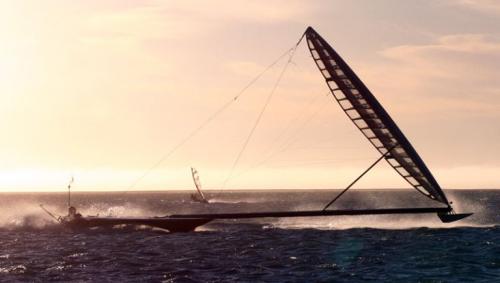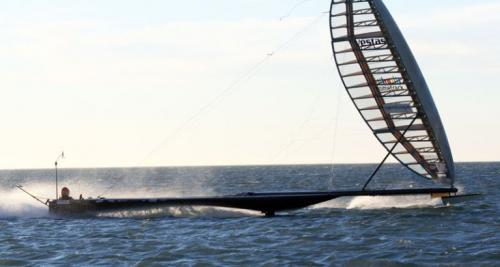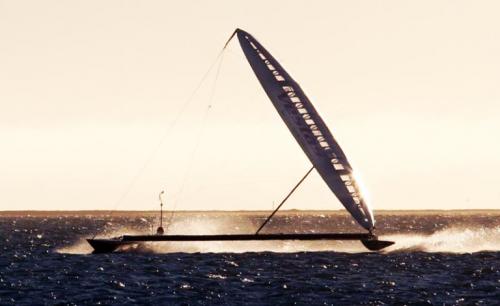A GORGEOUS DAY WITH TWO MORE 40+ KNOT RUNS POSTED...BUT...!!!
Sun, 25 May 08 22:17

Yesterday was one of the best days I have seen over at the Walvis Bay 'Speed-spot'.
The water was a beautiful blue as was the sky and the wind was pumping in at around 20 knots with higher gusts. We weaved VESTAS SAILROCKET through the ever increasing fleet of Hobie cats present on the lawn of the Walvis Bay Yacht Club and made our way across the lagoon. As ever I was keen to make a big run and continue our climb up the numbers. Rough rides in bumpy water with the large rudder down are no longer acceptable. The last two runs were both done with the large low speed rudder up and it felt great. Today I would test the effectiveness of the hand steering/skeg flap at speeds over 40 knots. New guy Klaus would be our fifth man.
The first run went well. I sailed in nice and tight and had a relatively smooth ride. This had the double benefit of keeping the spray down. I used the hand steering for the whole 500 meter course and it seemed quite effective. The low speed rudder failed to kick up due to... and I'll be honest... user error on my part. In the long list of checks I do in between dropping the tether at the start and actually turning VESTAS SAILROCKET onto the course and accelerating, I hadn't released the rudder pull-down line and this held the rudder down after I released the 'up' trigger. By the time I realised we were already approaching 40 knots. A mistake on my part but it didn't involve any risk.
So we hit a peak speed of 42.3 knots. The wing was sheeted to only 20 degrees throughout this run. The reason for this was that I sheet in initially when both my hands are free as it is harder once one hand is being used for steering. For these first high speed runs using the hand steering I am concentrating very hard on this aspect and not so hard on the wing angle. It will all come with practice and familiarity. The wing flap sheeted on nicely and it all felt fine. Although VESTAS SAILROCKET responded well to the hand steering... it still didn't feel entirely precise. I was still weaving around a little.
RUN 45, MEAN WIND SPEED 18.5 KNOTS, TOP SPEED 42.5. WING ANGLE AT 20 DEGREES, WING FLAP ON, LARGE RUDDER STILL DOWN. USING HAND STEERING. POD VERY 'FLOATY'... AS IS FRONT END!

At the end of the run I was keen to get back up the course and try it again. The wind had built a little and I wanted a new top speed but more importantly... I wanted to nail a 42.5 knot average over the course. This is a performance milestone that we have set ourselves which we are now slightly overdue to achieve. I know we are more than capable and want to get it in our wake ASAP.
In my mind I was going to focus on sailing in tight, making sure the large rudder is kicked up and making sure that the wing was sheeted in harder before going to hand steering. Vestas SailRocket strained at the tether line as she swung her nose away from the beach in a long arc prior to release. She quickly powered over the 'hump' and up onto her planing surfaces whilst I began to bear away and line up the start of the course. This is always a sensitive part of the run as it is usually the phase where, if we are not careful a rounding up force can overpower the steering and send me into the beach. This time we were OK and I felt the reassuring force of leeward helm which signalled that all was well and VESTAS SAILROCKET was sailing as she was designed to do.
HEADING UP TO THE COURSE THROUGH THE START UP SEQUENCE FOR RUN 46.

I sheeted the wing into 15 degrees and went to the hand steering. We were quickly up to 40 knots but I noticed I was using the full range of the skeg steering to hold the boat up onto the course. The aerodynamics were overpowering the hydrodynamics and the only way I could hold VESTAS SAILROCKET up onto the course was to put in a little bit of foot steering via the still deployed large rudder. This initiated a sharp turn to windward which is a little unsettling as it can instigate a high speed round-up. I was still at full forward lock on the hand steering so it was obvious that I couldn't kick up the big rudder. Visibility was good enough for me to be able to see the course. I held on for the full 500 meters and then brought the show to a stop.
The top speed was only slightly higher than the previous run but the run involved a lot more weaving. I wasn't happy. We should have done at least 45 knots in these conditions... and I mean at least. It was a perfect day.
So what happened? My first guess is that by sheeting in harder in slightly stronger winds on the second run, we simply had too much lee-helm i.e. the balance of the boat was making her want to turn away from the beach too hard. This can be quite quickly and easily compensated for in a number of ways. VESTAS SAILROCKET is a highly adjustable boat. We can either move the wing aft by swinging the beam or wing aft. This is done by simply adjusting the lashing lengths on the end of the fore and aft supporting cables. Another means of trim adjustment is to adjust the angle of the rear skeg to the main foil. This is done by a screw adjustment and is also quite simple. In all fairness, we can't expect our first stab at a high speed configuration to be exactly right and it will probably be something that we will be playing with until the end.
What does impress me about our current status is how smooth the whole operation is becoming. The overall, comfort, stress and functionality levels are all very good. We have the ability to just plug in a new team member and go and punch out consecutive 40 knot runs with little or no fuss. Although we still have many obstacles to overcome I really feel that we have emerged from our darkest days and that we are in great fighting shape. Our last big crash was on Run 23 and we have now doubled that amount of runs without incident.
I tried to go back for another run but as we got to the top of the course... the sun had made it to the horizon. We reluctantly packed up. I felt frustrated that we hadn't topped 44 knots at least but the fact is that we are always learning and in some cases it doesn't really matter if there is a tick or a cross in a certain box... as long as it answers a question that will show you the next direction you need to take.
CONCLUSION: Right now, at high speed in winds over 20 knots, the current boat configuration appears to be imbalanced to the point where the skeg steering cannot correct it. We need to reconfigure the boat. One good aspect is that VESTAS SAILROCKET is trying to turn away from the beach and hence danger in this setup. The visibility was improved in the cockpit by sailing in closer to the beach and hence in flatter water.
The data from the PI RESEARCH, B and G and TACKTICK loggers has all been downloaded and sent off to Malcolm. Both the onboard footage with pilot audio and the onshore footage with audio has been downloaded and co-ordinated with the PI RESEARCH data so that we can watch all the data and footage together on the computer in real time. It is a brilliant system that allows you to go back and really study the reality of a certain moment in time in intricate detail.
The weather does not look that favourable today as it is forecast to be quite light. In fact the rest of the week looks pretty average which means we will lose the remainder of this afternoon high tide. Things might change so we will stay on standby nonetheless. One of the main contenders for 50 knots, Hydroptere, is now back in the water and ready for sailing. She looks fantastic and I am eager to see what her new configuration will yield. Of course we want to beat her on the water and are doing all we can to do so. I am honestly glad that they are back and as hungry as ever to go faster. The competition is a healthy one.
Cheers, Paul